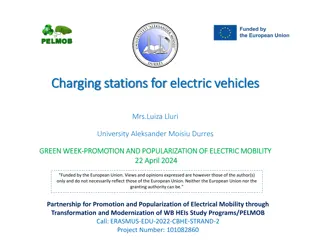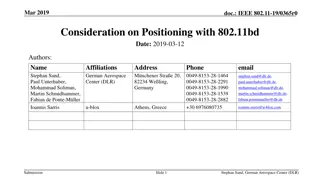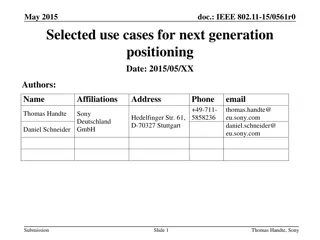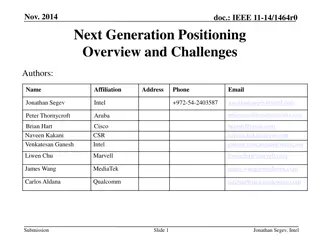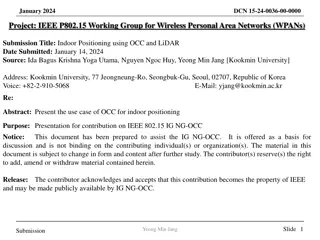Real-time Indoor Positioning System for Subway Stations
This presentation discusses a real-time indoor positioning system for subway stations using cell phones. It covers server-side tracking of users' phones, data collection for trajectory analysis, client-side navigation services in GPS-denied environments, and localization technologies such as radio fingerprinting and Pedestrian Dead-Reckoning. The system addresses challenges like body block effects and environmental variations while establishing a database with high accuracy for pedestrian mapping support.
Download Presentation

Please find below an Image/Link to download the presentation.
The content on the website is provided AS IS for your information and personal use only. It may not be sold, licensed, or shared on other websites without obtaining consent from the author.If you encounter any issues during the download, it is possible that the publisher has removed the file from their server.
You are allowed to download the files provided on this website for personal or commercial use, subject to the condition that they are used lawfully. All files are the property of their respective owners.
The content on the website is provided AS IS for your information and personal use only. It may not be sold, licensed, or shared on other websites without obtaining consent from the author.
E N D
Presentation Transcript
Subway Station Real-time Indoor Positioning System for Cell Phones Chengqi Ma1 Chenyang Wan1; Yuen Wun Chau1; Soong Moon Kang2; David R. Selviah1; 1Department of Electronic & Electrical Engineering 2School of Management University College London, UCL The International Conference on Indoor Positioning and Indoor Navigation (IPIN 2017) Presentation by Chengqi Ma, 2017/9/20 1
Introduction Server Functions Server side: Tracking users cell phones. Collect data for study of users trajectories and monitoring congestion. Client side: Navigation services in GPS-denied environments. Clients(real time) The International Conference on Indoor Positioning and Indoor Navigation (IPIN 2017) Presentation by Chengqi Ma, 2017/9/20 2
Introduction Localization Technologies: A radio fingerprint is the pattern of radio signal strength measurements that is observed at a given location. It comprises a vector of signal identity information (e.g. Wi-Fi MAC addresses, or cellular Cell-IDs) and a corresponding vector of values of Received Signal Strength (RSS). Wi-Fi Fingerprinting Pedestrian Dead-Reckoning (PDR) Signal processing Technology: Kalman Filter The International Conference on Indoor Positioning and Indoor Navigation (IPIN 2017) Presentation by Chengqi Ma, 2017/9/20 3
Problems and Challenges 14m 1) Body block effect This is an example of the RSS distribution on a straight platform received from one AP when the device holder walks back and forth ten times. The International Conference on Indoor Positioning and Indoor Navigation (IPIN 2017) Presentation by Chengqi Ma, 2017/9/20 4
Problems and Challenges 2) Environmental variation effect Unstable signal strength Wi-Fi signal (space/time) Sensor data from cellphone Environment variation Periodically arriving and departing metallic trains Group of people during different time periods The International Conference on Indoor Positioning and Indoor Navigation (IPIN 2017) Presentation by Chengqi Ma, 2017/9/20 5
Database Establishment 1) Pedestrian Dead-reckoning (PDR) mapping support Testing set number 1 2 3 Actual steps 100 100 100 Average measured steps 97 98 103 Null steps 3 2 4 Average 1.89 metres 1.26 metres 1.89 metres accumulated error Overall accuracy 97.3% The International Conference on Indoor Positioning and Indoor Navigation (IPIN 2017) Presentation by Chengqi Ma, 2017/9/20 6
Database Establishment 2) Unique RSS distributions probability density function (PDF) fingerprint 3) Extra information Probability of occurrence R Maximum number of collected datapoint in all APs Direction coefficient D Number of collected datapoint from current AP = R RSS histogram distributions from one AP at different reference points. The International Conference on Indoor Positioning and Indoor Navigation (IPIN 2017) Presentation by Chengqi Ma, 2017/9/20 7
Database Establishment 4) Database Scale Around 40 APs can be detected at one reference point 2382 reference points in two stations. 1104 detectable APs Data collecting work through a whole month The International Conference on Indoor Positioning and Indoor Navigation (IPIN 2017) Presentation by Chengqi Ma, 2017/9/20 8
Online Matching Phase The International Conference on Indoor Positioning and Indoor Navigation (IPIN 2017) Presentation by Chengqi Ma, 2017/9/20 9
Online Matching Phase 1) MAC address matching The International Conference on Indoor Positioning and Indoor Navigation (IPIN 2017) Presentation by Chengqi Ma, 2017/9/20 10
Online Matching Phase 2) Feature Matching ia Pr ' | = | ( = ', ',..., ') A s A a a a 0 1 x k xs is a single tracking data RSS detected from one AP = ( , ,..., ) A a a a is the feature distribution of the AP at one 0 1 k reference point = | ' / 2, i (0, ) Pr p a BW k i i Number of feature matched AP 70% Number of detectable AP The International Conference on Indoor Positioning and Indoor Navigation (IPIN 2017) Presentation by Chengqi Ma, 2017/9/20 11
Online Matching Phase 3) Probability Mark Selection For each selected reference point, we define and calculate a Mark to evaluate the matching probability n = R D Pr i i = 0 i Mark n k-nearest neighbours selection function k n 5% , Mark Mark k n i i = = 0 0 i i The International Conference on Indoor Positioning and Indoor Navigation (IPIN 2017) Presentation by Chengqi Ma, 2017/9/20 12
Online Matching Phase 4) Discrete Kalman Filter The Kalman filter is a widely used signal processing technique for trajectory optimization. It is a two-step algorithm for linear systems to help improve the estimation of their next states. Based on a given system s current state and a dynamic model of the target trajectory, it initially predicts the next state of the system. The next step combines the predicted value with the actual value, giving rise to a more accurate estimate of the next state. Trajectory smoothing Matching failed point prediction The International Conference on Indoor Positioning and Indoor Navigation (IPIN 2017) Presentation by Chengqi Ma, 2017/9/20 13
System performance in separated areas Off- peak time Peak time Experiment area Matching result Filtered result Matching result Filtered result Platform 1.97 m 1.50 m 4.91 m 2.62 m Tunnel 1.92 m 1.72 m 2.15 m 1.79 m Escalator up 1.23 m 1.23 m 4.23 m 3.55 m Escalator down 0.91 m 1.18 m 2.73 m 2.66 m The International Conference on Indoor Positioning and Indoor Navigation (IPIN 2017) Presentation by Chengqi Ma, 2017/9/20 14
System performance overall Off- peak time Peak time System performance Matching result Filtered result Matching result Filtered result Overall average error distance 2.37 m 1.71 m 3.42 m 2.90 m 80% CDF error distance < 2.91 m < 2.54 m <4.77 m <4.2 m The International Conference on Indoor Positioning and Indoor Navigation (IPIN 2017) Presentation by Chengqi Ma, 2017/9/20 15
Acknowledgements The authors wish to thank the subway station operators for allowing us to carry out the experiments reported in this paper Thank to my supervisor Dr David Selviah. Also thank to Dr Soong Moon Kang to provide this research opportunity. Thank you all for listening ! The International Conference on Indoor Positioning and Indoor Navigation (IPIN 2017) Presentation by Chengqi Ma, 2017/9/20 16










